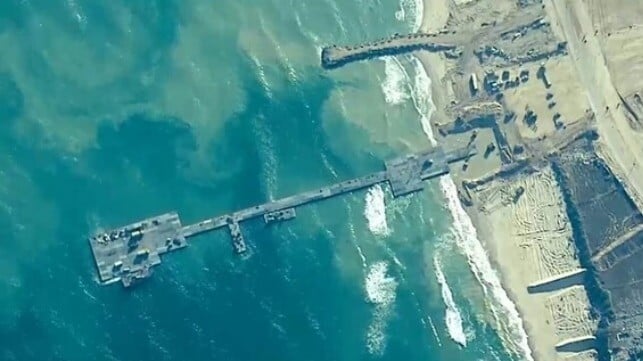Gaza Aid Pier Restored After Repairs as U.S. Plans to Increase Aid Flow

U.S. officials announced that after nearly two weeks of repairs, the temporary aid pier has been restored in Gaza. Speaking to reporters, Vice Admiral Brad Cooper, Commander of U.S. Naval Forces, said they were optimistic about increasing the flow of aid while politicians and others continue to criticize the efforts.
“I’m very pleased to announce that earlier this morning, in Gaza, U.S. forces successfully attached the temporary pier to the Gaza beach,” CNN reports Cooper told reporters. “Israeli Defense Force engineers provided all the necessary support to ensure the safe emplacement of the pier to the beach.”
The goal was to restore the operations in the coming hours and again start the flow of food, water, and other relief supplies into Gaza. The operation was suspended on May 25 after what the U.S. command called “unanticipated weather” damaged sections of the floating pier and caused it to break apart. Sections washed ashore along with two U.S. landing craft, all of which have now been recovered from the beach.
The Washington Post citing unnamed sources at the Pentagon said the anticipated repair costs would be between $22 and $28 million. The sections of the pier were taken to the Israeli port of Ashdod, north of Gaza, for repairs, and reinstalled this morning, June 7. Pentagon officials also highlighted that the effort is costing less than originally anticipated due to lower costs for the drivers and due to the British involvement. They now set the cost at approximately $230 million depending on the length of time it is used down from an earlier estimate of $320 million.
The pier was designed they said to work in one-to-two-foot seas and they expect the Mediterranean is starting a period of relative calm. Reports said the seas were up to about five feet when the pier broke apart.
U.S. officials contend that the effort was gradually increasing volumes and that some of the problems had been resolved. More than 1,100 tons of material they said had been landed between May 17 and 25 but admitted there had been problems getting the material from the dock to the warehouses. U.S. Navy personnel are only on the ships and the dock, not going ashore or handling the material as it is transferred to the distribution warehouses.
A new safer route has been established to prevent the convoys from being looted. Some reports said as many as 11 of the 16 vehicles had been overrun and supplies stolen before reaching the warehouse run by independent aid organizations.
“It is astonishing that President Biden is doubling down on this bad idea,” said U.S. Senator Roger Wicker, a Republican from Mississippi and member of the U.S. Senate Armed Services Committee. A vocal political critic using the project for political gain, he is calling for the effort to “end immediately.”
Experts point out that with no natural harbor or cove, the pier is exposed to the elements. Despite this, U.S. officials are saying they expect the pier will function well and that they can begin to further increase the movement of relief supplies. The goal is to get 500,000 pounds per day across the beach and then ramp up after that.
